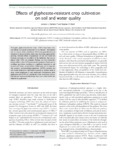Please use this identifier to cite or link to this item:
http://www.alice.cnptia.embrapa.br/alice/handle/doc/872430| Title: | Effects of glyphosate-resistant crop cultivation on soil and water quality |
| Authors: | CERDEIRA, A. L.  DUKE, S. O.   |
| Affiliation: | ANTONIO LUIZ CERDEIRA, CNPMA; Stephen O. Duke, USDA-ARS. |
| Date Issued: | 2010 |
| Citation: | GM Crops,Austin, v. 1, n. 1, p. 16-24, 2010. |
| Description: | Transgenic glyphosate-resistant crops (GRCs) have been com- mercialized and grown extensively in the western Hemisphere and, to a lesser extent, elsewhere. GRCs have generally become dominant in those countries where they have been approved for growing. Potential effects of glyphosate on soil and water are minimal, compared to the effects of the herbicides that are re- placed when GRCs are adopted. Perhaps the most important indirect effect is that GRCs crops promote the adoption of re- duced- or no-tillage agriculture, resulting in a signifcant reduc- tion in soil erosion and water contamination. Glyphosate and its degradation product, aminomethylphosphonate (AMPA), residues are not usually detected in high levels in ground or surface water in areas where glyphosate is used extensively. Furthermore, both glyphosate and AMPA are considered to be much more toxico- logically and environmentally benign than most of the herbicides replaced by glyphosate. |
| NAL Thesaurus: | Glyphosate Soil Water Environment |
| Keywords: | Resistência a herbicida Herbicide-resistant crops |
| Type of Material: | Artigo de periódico |
| Access: | openAccess |
| Appears in Collections: | Artigo em periódico indexado (CNPMA)  |
Files in This Item:
| File | Description | Size | Format | |
|---|---|---|---|---|
| 2010AP032.pdf | 678,1 kB | Adobe PDF |  View/Open |









